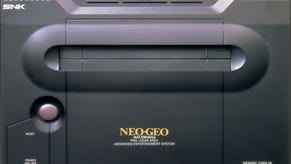The King of Fighters 14 review
In with the Neo.
Frame the rivalries between Japanese fighting game series as a pugilistic tournament and, for the past few years, Capcom's Street Fighter has held its title unchallenged. The field wasn't always so uncontested. Throughout the 1990s SNK's King of Fighters ably faced Street Fighter, pitting its forte - technical intricacy - against that of the latter - an iconic cast. It was a rivalry worthy of myth: both games were originated by the same man, Takashi Nishiyama, who, having designed the original Street Fighter at Capcom, left (under a dark cloud, some say) to run SNK's development division. In a final, fanciful twist Nishiyama went on to found Dimps, the company responsible for Street Fighter's triumphant return in 2008.
Like a prizefighter falling from the wagon, King of Fighters tumbled into relative obscurity in the early 2000s, a victim, in part, of SNK's tumultuous corporate wrangling. Street Fighter's renaissance was left largely unchallenged. In video games, as in government, one can never underestimate the value of strong opposition; without it, complacency sets in and the urge to deliver deadens - here's looking at you, Street Fighter 5. So it is that King of Fighters 14 makes a return that's welcome not only for reviving a beloved series, but also to diversify the field.
For beginners, the greatest difference between King of Fighters and its rivals is that this is three vs three game, although, unlike in Marvel vs Capcom your chosen trio cannot tag in and out during rounds. Knock-out one of the opponent's characters and, when their replacement arrives, you gain some health back, the amount of which is dependent on how much time was left on the clock when the previous round ended (a mechanic that's never explained). In the event of a draw, both characters are deemed to have lost, and each player must move on to the next character in line. The aim, as ever, is to be the last player standing.

The series' notorious technical depths remain (there are, for example, three types of jump, each one with a different range, each one triggered by a slightly different joystick waggle). But director Yasuyuki Oda, the battle designer for genre classic Garou: Mark of the Wolves who previously worked on Capcom's Street Fighter 4 (you couldn't make this up) understands only too well the need to lower the bar of entry in order to make a commercial fighting game success in the 21st Century. In fact, Oda has said that, of all games in the series, he wants King of Fighters 14 to be "the easiest to play."
Enter the 'Rush Combo'. Close the distance to an opponent and mash the light punch button and every character in the game will execute a dazzling combo. If you have some special meter accrued, it will even tag on an explosive finisher. Auto-combos may seem like an inexcusable dumbing down, but in reality they allow every player to ease into a new character, while, for experts, the capacity to interrupt the stream of attacks with cancels and special moves makes this a fundamental building block for advanced play, rather than a redundant training wheel.
Work your way through the expansive training mode and you soon come to understand the sheer range of mechanics folded into the game. King of Fighters 13's HD system is gone, replaced with the MAX Mode mechanic from earlier instalments. This provides a short-lived boost at the cost of a single bar of meter and allows you to trigger an unlimited number of special attacks while active. Beyond these powerful EX moves, there are no fewer than three levels of 'Supers'. There are also Command Throws (which can't be countered), a feature known as Blow Back (which smashes your opponent against the facing wall to instantly create distance between you) and Emergency Evasion, a move similar to Street Fighter 3's parries, which can also be used to recover quickly when knocked down.
There are Special moves, Super Special moves, MAX Super Special moves and Climax Super Special Moves, each one a more ludicrous escalation and a further interaction to lean how and when to deploy. The result of this breadth is both extreme complexity and extreme flexibility. At the higher levels of competitive play, King of Fighters 14 promises to thrill audiences, while simultaneously presenting live commentators with one of their greatest challenges yet.
For the lone single player, it's a more routine offering. The storyline is a well-worn cliché: a global tournament to find the greatest fighter in the world, with the final taking place in the Antonov Super Arena, a cavernous stadium lined with fire-gobbing mini volcanoes, and a velvet-draped stage of the kind that one could imagine Vladimir Putin commissioning and then strutting around. As every match consists of three bouts, a playthrough takes much longer than in recent Street Fighters, but there are dollops of cutscene and various unlockables to maintain interest.

Players hoping for a return to the pixel art mastery of SNK's former years will be disappointed. Unlike Arc Systems, a company that has managed to preserve the aesthetic of its formative games while moving into full 3D, King of Fighters 14 has lost much of the charm of its forebears. Models are anaemically lit, and everything has a washed-out, dated look. Shortcomings in style are made up for in bulk. The game's starting roster comprises 48 characters, including SNK's classic fighters, Kyo Kusanagi and Terry Bogard (SNK's Ryu and Ken) and many other long-in-the-tooth faces, such as Iori Yagami, Mai Shiranui. There are even loan characters from other SNK series, such as Samurai Shodown's Nakoruru who is, naturally, accompanied by that stabby eagle. The game's 18 vivid stages shame Street Fighter 5's comparatively impoverished launch.
While online matches ahead of the game's launch are scarce (with no ranked matches available at all) Free Match mode, which allows up to twelve players to pair off and fight in either one on one or three vs three matches show the game's rewritten netcode to be a significant improvement- a strength that doesn't quite make up for the fussy and confusing menu layouts. It's a long way from the quality of Guilty Gear Xrd Revelator's adorable 64-player lobbies, but arguably the best that this series has yet seen.
King of Fighters 14 has chosen the perfect moment at which to enter the fray. Like a wizened fighter, lured from his flabby retirement by a master trainer whose belief in his student has never wavered, this is an inspiring return. Yasuyuki Oda's masterly knowledge of the fighting game genre is clearly evident and, at its fundamental level, this is a game that can, finally, go toe-to-toe with Capcom's prizefighter. It remains the more complicated, elbow-y game, but for those able to master its intricacies, a superb one.




